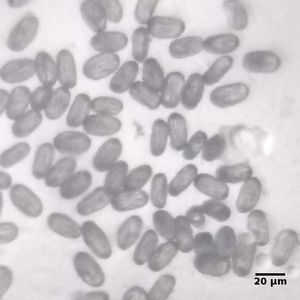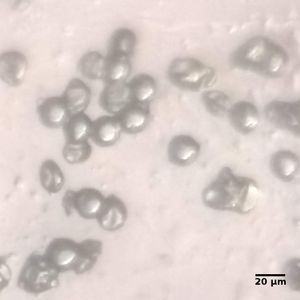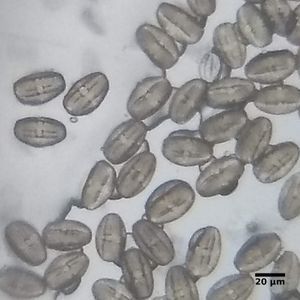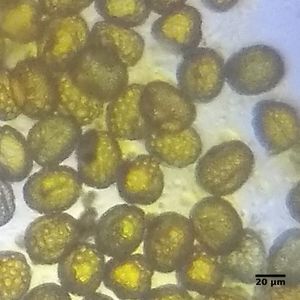Measuring pollen (Peacock flower pollen)
 May 25, 2018 • 11:31 AM UTC
May 25, 2018 • 11:31 AM UTC Unknown Location
Unknown Location 140x Magnification
140x Magnification Microorganisms
Microorganisms
varuni
Learn about the author...
21posts
22comments
1locations
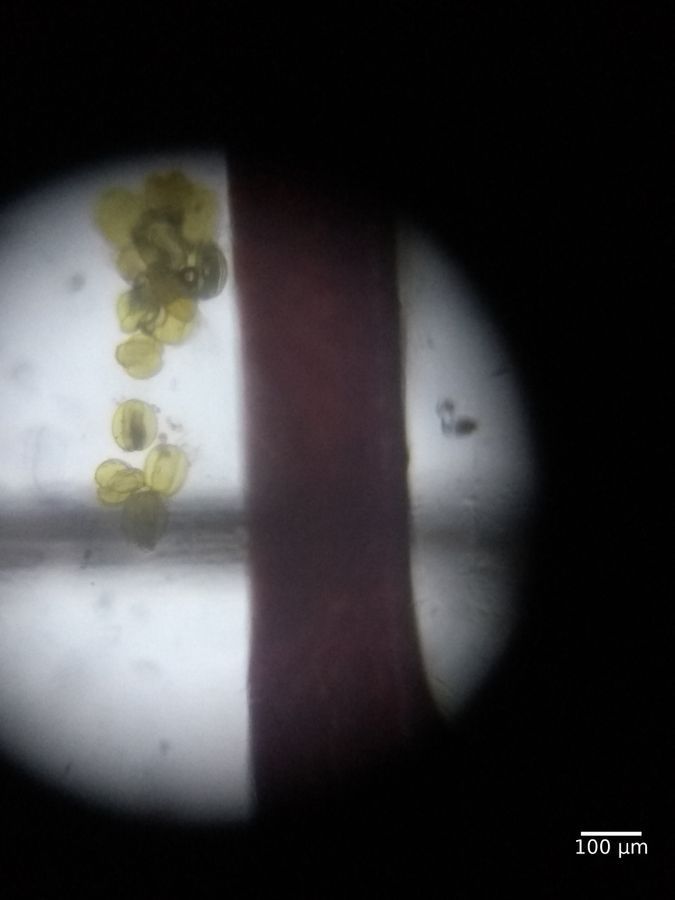
Here’s a common shrub in Chennai:
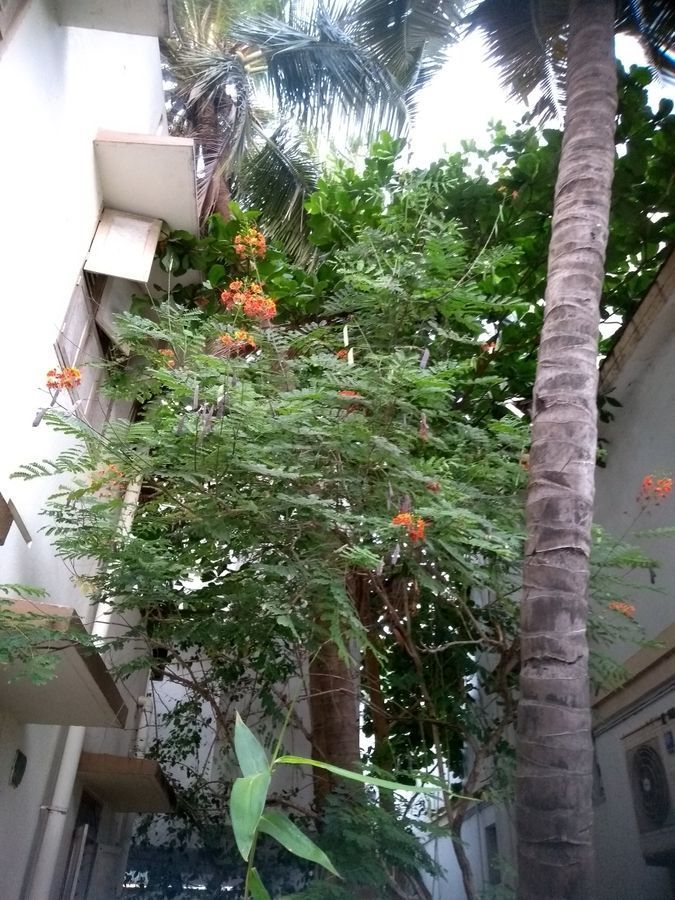
I think there is also a variant with bright yellow flowers. I don’t know the species name, but I’ve posted it on India Biodiversity Portal to see if anyone there can ID it.
Heres its pretty flower:
Heres its pretty flower:
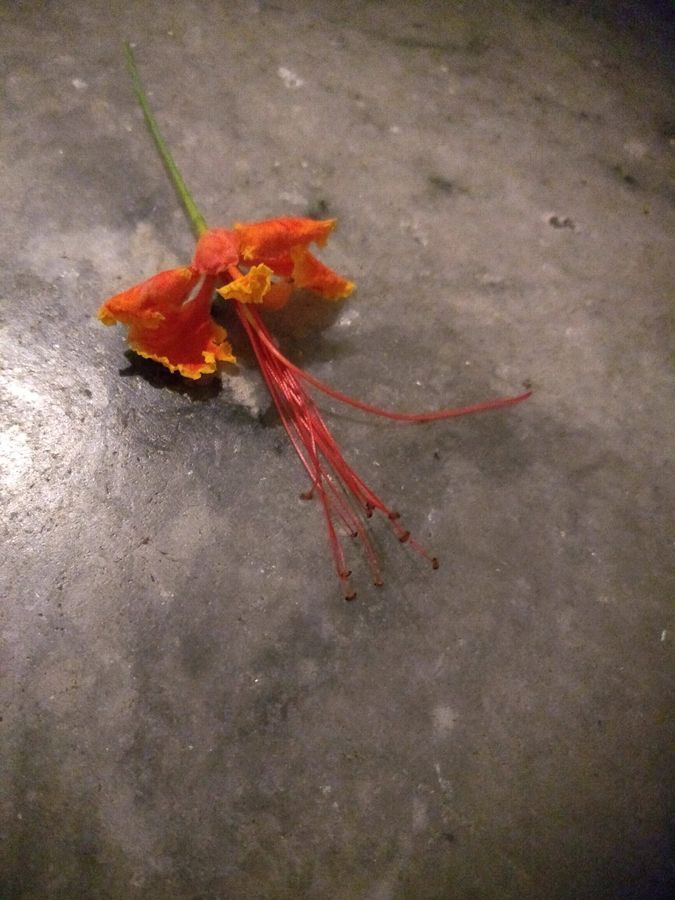
There’s a lot of easy to see pollen on the anthers — enough that some of it has spilled onto the filaments. So I put that on a slide and looked at it:

I have also been thinking about how to measure pollen size. In the comments to one of my previous posts on
Karuvaipillai
pollen , it was suggested that I use the background grid to calibrate the image like done here:
Measuring the Foldscope Universe-1: Using the kit scale
I did just that with this nifty open source image analysis software called Fiji (previously ImageJ) to calibrate the image:
measure the number of pixels covered by the thickness of grid line divide that by 100 microns (thats apparently the actual thickness of the grid lines) you have a pixel <—> micron conversion! For this image it turns out, the thickness of the grid line is ~312 pixels. So a 100 micron scale bar needs to 312 pixels in length. 🙂
More generally, for this image, 1 pixel = 0.32 microns. To measure the pollen, just see how many pixels it spans: these span about 244 pixels (lengthwise) so they are ~80 microns long. Similarly, we can measure pretty much anything else in this field of view!
Now, in addition to observing that our pollen has 3 lobe-sort-of-things, I can estimate that the pollen is about 80 microns long and that each “lobe” is about 30 microns in diameter.
ERRATUM: There seems to be an error in this measurement, that I think has to do with the grid line being out of focus. Please see my post about the correction here:
More Measurements
As a side bar, I learnt that these “lobes” are actually because of elongated furrows on the pollen coat called colpi (singular: colpus). These allow pollen grains to shrink and swell in response to moisture with out totally desiccating or bursting. Our little pollen of unknown shrub, has 3 colpi. In fact, Eudicots ( most flowering plants) have pollen with 3 colpi (or some evolutionary derivative of it) and because of this conserved evolutionary trait, the members of this clade are often called Tricolpates after their pollen!!
Anyway, coming back to measuring pollen, a harder problem is what happens in you don’t have nice a grid line in the background — either its really out of focus or the area you zoomed into has really cool pollen but no grid lines?? I think I may have a solution for this too. But you will have to wait for my next post…
This post is open to read and review on The Winnower.
Karuvaipillai
pollen , it was suggested that I use the background grid to calibrate the image like done here:
Measuring the Foldscope Universe-1: Using the kit scale
I did just that with this nifty open source image analysis software called Fiji (previously ImageJ) to calibrate the image:
measure the number of pixels covered by the thickness of grid line divide that by 100 microns (thats apparently the actual thickness of the grid lines) you have a pixel <—> micron conversion! For this image it turns out, the thickness of the grid line is ~312 pixels. So a 100 micron scale bar needs to 312 pixels in length. 🙂
More generally, for this image, 1 pixel = 0.32 microns. To measure the pollen, just see how many pixels it spans: these span about 244 pixels (lengthwise) so they are ~80 microns long. Similarly, we can measure pretty much anything else in this field of view!
Now, in addition to observing that our pollen has 3 lobe-sort-of-things, I can estimate that the pollen is about 80 microns long and that each “lobe” is about 30 microns in diameter.
ERRATUM: There seems to be an error in this measurement, that I think has to do with the grid line being out of focus. Please see my post about the correction here:
More Measurements
As a side bar, I learnt that these “lobes” are actually because of elongated furrows on the pollen coat called colpi (singular: colpus). These allow pollen grains to shrink and swell in response to moisture with out totally desiccating or bursting. Our little pollen of unknown shrub, has 3 colpi. In fact, Eudicots ( most flowering plants) have pollen with 3 colpi (or some evolutionary derivative of it) and because of this conserved evolutionary trait, the members of this clade are often called Tricolpates after their pollen!!
Anyway, coming back to measuring pollen, a harder problem is what happens in you don’t have nice a grid line in the background — either its really out of focus or the area you zoomed into has really cool pollen but no grid lines?? I think I may have a solution for this too. But you will have to wait for my next post…
This post is open to read and review on The Winnower.
Sign in to commentNobody has commented yet... Share your thoughts with the author and start the discussion!
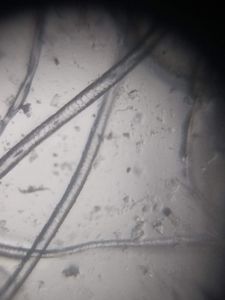
 0 Applause
0 Applause 0 Comments
0 Comments
